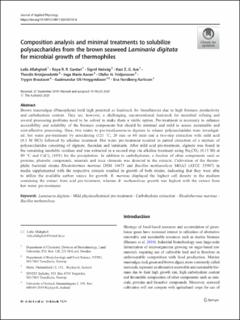| dc.contributor.author | Allahgoli, Leila | |
| dc.contributor.author | Sardari, Roya | |
| dc.contributor.author | Hakvåg, Sigrid | |
| dc.contributor.author | Ara, Kazi | |
| dc.contributor.author | Kristjansdottir, Thordis Anna | |
| dc.contributor.author | Aasen, Inga Marie | |
| dc.contributor.author | Fridjonsson, Olafur | |
| dc.contributor.author | Brautaset, Trygve | |
| dc.contributor.author | Hreggvidsson, Gudmundur O. | |
| dc.contributor.author | Nordberg Karlsson, Eva | |
| dc.date.accessioned | 2020-10-16T09:16:46Z | |
| dc.date.available | 2020-10-16T09:16:46Z | |
| dc.date.created | 2020-05-14T09:32:02Z | |
| dc.date.issued | 2020 | |
| dc.identifier.issn | 0921-8971 | |
| dc.identifier.uri | https://hdl.handle.net/11250/2683275 | |
| dc.description.abstract | Brown macroalgae (Phaeophyta) hold high potential as feedstock for biorefineries due to high biomass productivity and carbohydrate content. They are, however, a challenging, unconventional feedstock for microbial refining and several processing problems need to be solved to make them a viable option. Pre-treatment is necessary to enhance accessibility and solubility of the biomass components but should be minimal and mild to assure sustainable and cost-effective processing. Here, two routes to pre-treatLaminaria digitata to release polysaccharides were investigated: hot water pre-treatment by autoclaving (121 °C, 20 min or 60 min) and a two-step extraction with mild acid (0.1 M HCl) followed by alkaline treatment. Hot water pre-treatment resulted in partial extraction of a mixture of polysaccharides consisting of alginate, fucoidan and laminarin. After mild acid pre-treatment, alginate was found in the remaining insoluble residues and was extracted in a second step via alkaline treatment using Na2CO3 (0.15 M) at 80 °C and CaCl2 (10%) for the precipitation. In addition to carbohydrates, a fraction of other components such as proteins, phenolic compounds, minerals and trace elements was detected in the extracts. Cultivation of the thermophilic bacterial strains Rhodothermus marinus DSM 16675 and Bacillus methanolicus MGA3 (ATCC 53907) in media supplemented with the respective extracts resulted in growth of both strains, indicating that they were able to utilize the available carbon source for growth. R. marinus displayed the highest cell density in the medium containing the extract from acid pre-treatment, whereas B. methanolicus growth was highest with the extract from hot water pre-treatment. | en_US |
| dc.language.iso | eng | en_US |
| dc.publisher | Springer Link | en_US |
| dc.rights | Navngivelse 4.0 Internasjonal | * |
| dc.rights.uri | http://creativecommons.org/licenses/by/4.0/deed.no | * |
| dc.subject | Laminaria digitata | en_US |
| dc.subject | Bacillus methanolicus | en_US |
| dc.subject | Rhodothermus marinus | en_US |
| dc.subject | Carbohydrate extraction | en_US |
| dc.subject | Mild physicochemical pre-treatment | en_US |
| dc.title | Composition analysis and minimal treatments to solubilize 6 polysaccharides from the brown seaweed Laminaria digitata 7 for microbial growth of thermophiles | en_US |
| dc.type | Peer reviewed | en_US |
| dc.type | Journal article | en_US |
| dc.description.version | publishedVersion | en_US |
| dc.rights.holder | The Authors 2020 | en_US |
| dc.source.pagenumber | 1933–1947 | en_US |
| dc.source.volume | 32 | en_US |
| dc.source.journal | Journal of Applied Phycology | en_US |
| dc.identifier.doi | 10.1007/s10811-020-02103-6 | |
| dc.identifier.cristin | 1810918 | |
| dc.relation.project | EC/H2020/720755 | en_US |
| cristin.ispublished | true | |
| cristin.fulltext | original | |
| cristin.qualitycode | 1 | |

